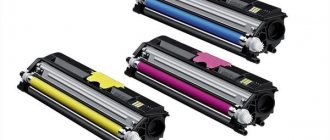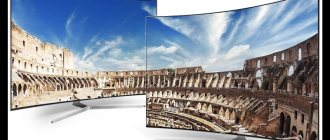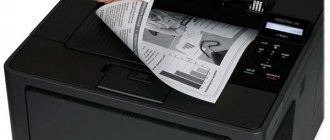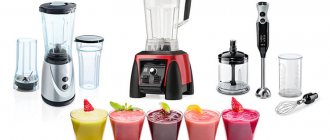LED technology has become quite widespread over the past few years. Not the last of their applications is printing devices, in other words, LED printers and MFPs. Laser presses were not long ago the pinnacle of printing technology, but these days consumers have a wide range of choices. On the one hand, this gives freedom, on the other hand, it gives rise to doubts: which device to take so as not to make a mistake?
LEDs in printing
Comparing laser and LED printing technologies is difficult. It cannot be said that one of them is categorically better than the other. Both options have their advantages. The history of the black and white LED printer began back in 1987, when the first model went on sale. A practical, affordable color device was presented to customers only a decade later. True, the models of the 90s era were not of very high quality, which spoiled the reputation of the technology as a whole.
In many ways, color LED printers have proven to be not very good devices, because users themselves made mistakes when operating the devices. Many used cheap, low-quality toners, others used the machines too actively, exceeding their service life several times over. The high popularity of this type of device in our country in the 90s was explained by its low cost. Now the price of LED printers is higher, but the machines have also become much more reliable.
Laser or LED... Which printer is better?
First of all, you need to know what tasks will be assigned to the printing device. For home use, it makes no difference what type of printer it is: laser or LED. Also, such a parameter as printing speed is not a priority. A mid-class monochrome laser printer at an affordable price (HP LJ Ultra M106w, Canon LBP6030B, Brother HL-1202) is quite suitable for home use. It is easy to install/replace the cartridge in them yourself. The main thing is not to buy the cheapest laser printers with a “chip” cartridge, which excludes refilling.
Which printer is best to buy for a small office or government agency? Where you need to make hundreds of black and white prints every day, there is no equal to a monochrome laser printer from the professional series. In other cases, the best option would be a color LED multifunctional device (MFP), which has the ability not only to print, but also to scan, copy, and fax. As a rule, such devices have an additional set of options with support for duplex printing, scaling and network connectivity.
Only a color LED printer or professional series MFP (for example, Xerox WorkCentre 6515DNI) can cope with the diverse tasks of large companies and enterprises. In this case, all the disadvantages of LED printers are offset by two important advantages: high reliability and secure printing. In addition, all connected users have access to printing from mobile devices via Wi-fi.
Please note that on some online resources for selling computer equipment, LED printers are referred to as laser printers, without any explanation in the “technical specifications”. For what purpose this is being done, one can only guess. Therefore, it is better to find out the type of printing on the official website of the manufacturer.
The almost complete lack of competition between laser and LED printers on the Russian market does not allow the latter to regain at least part of their former glory. But the problem is not difficult to solve - by distributing advertising through the media, which could convey to the Russian consumer the information that modern LED printers and MFPs are perfect for home and office.
Device specifics
LED and laser printing devices are built on similar operating principles. Inside the machine there is a printing roller, areas of which are sensitive to light. Experts call this part a photodrum. Under the influence of light, a coloring substance sticks to the desired areas of the part, which is then transferred to the paper. Modern LED printers can print on thermal paper, and not just on regular A4 sheets.
When printing, the roller passes over the paper material, pressing on it. This allows you to create a clear trace. The paper with toner is sent to a heating system, where the high temperature allows the ink component to firmly adhere to the material. All this happens in a matter of seconds between pressing the “Print” key and the finished sheet leaving the print tray. By the way, seconds are not a figurative expression. For example, a Xerox LED printer can produce a print in just 4 seconds.
Principle of operation
The heart of any printing device (printer, MFP, copier) operating on the principle of dry electrostatic transfer is a photoroll (also known as a photodrum, photocylinder), the surface of which is coated with a photosensitive conductive material. During operation, light enters certain areas of the pre-charged surface of the photoroll, as a result of which the sign of the charge at these points changes. In an LED printer, illumination is produced by thousands of tiny narrowly directed LEDs, assembled in the form of a line and located along the entire photo roll. Simply put, a short-term glow of one LED will form a point on the future picture.
In a laser device, high image accuracy is ensured by a single laser diode, the beam of which passes through a complex system of lenses and mirrors. This is the main difference between a laser and LED printer.
Otherwise, the operating principle of a laser and LED printer is not much different. Rotating, the photo roller comes into contact with a magnetic roller coated with a layer of powdered toner. Having an opposite charge, the toner adheres to the exposed areas of the photodrum, forming a graphic image on them. With further rotation, the photodrum comes into contact with the paper, transferring an image of dry powder onto it. Firm contact with the paper is ensured by the pressure roller. The sheet then passes through a thermal unit, where, under the influence of temperature, the toner penetrates the paper and hardens. This results in a finished black and white print. The color print is formed differently. To create it, 4 toners (yellow, magenta, cyan and black) must be applied to a sheet of paper in a certain ratio and then fixed in a thermal unit. Currently, the most widespread is single-pass printing technology, in which 4 cartridges with photodrums are placed one behind the other (tandem) along the transport belt. During operation, the paper slides along the belt and takes toner from each drum unit in turn. As a result, a full-color image is formed very quickly and in just one pass. In addition, the single-pass method allows you to print on high-density paper, the maximum format of which is limited only by the size of the cartridges. If you need to make a black and white print, 3 color toner cartridges rise above the paper and are temporarily not involved in the work. This allows you to extend their working life and increase the speed of b/w printing.
Multi-pass technology involves full-color printing in 4 revolutions of the photo roll, during each of which a toner of the same color is applied to its surface, after which the resulting mixture is transferred to paper. The slow but mature technology continues to be used in low-cost color LED and laser printers.
Is there a difference?
The operation scheme described above is the same for laser and LED printing devices. But if we talk about the differences between these types of machines, then you should understand the structure of the printing roller, which fixes the toning component on the paper.
A laser printer has a special laser that works through prisms and mirrors. But inside the LED color printer there are numerous LEDs. They “decorate” the shaft along its entire length, which makes the system of prisms and mirrors unnecessary.
Black and white printing technology
The principle of black and white printing is simple: LEDs remove the charge from the points to which the toner is attracted. Compared to color analogues, here the source file is not decomposed into four colors. These printer models are cheaper. In addition, they have a decent speed and cost per printed sheet.
The photocylinder has a working resource. In the case of a color printer, the indicated number is immediately divided by 4, which may indicate the durability of black and white options.
LED printer: advantages and disadvantages
Printing machines designed using LED technology have a number of important advantages, which is why they are very popular. For example, the units are quite compact. This is explained by the small-sized lighting system, which occupies the bulk of the internal volume of the machine. Moreover, for monochrome units the difference is not too significant, but for color ones you can immediately notice where the printer is with LEDs and where with a laser.
Another important difference between a laser printer and an LED printer is the method of forming an image on paper. The LED mechanism is much simpler since there is no need for moving elements. Well, the simpler the design of the machine, the more reliable the device and the longer its service life. However, this only applies to a well-made unit, which is regularly serviced and refilled with good toner. If we talk about service, this is another important difference between a laser printer and an LED printer. A device with LEDs will be cheaper: technical checks and repairs are required less frequently, and they are somewhat simpler.
Advantages of a conventional laser printer
Against this background, a conventional laser printer begins to seem somewhat outdated and not even very popular. However, if you look away from the comparison, it becomes clear that it has its advantages:
- No need for frequent refilling of cartridges
. This is a constant scourge of inkjet printers - they run out of ink quickly, and not every user can learn how to refill them. It’s easier with toner: it doesn’t dry out over time and is used much more economically.
- Not afraid of increased loads
. There are no elements that could overheat, no elements that could dry out. Easily copes with loads that would reliably damage an inkjet device.
- Has good print quality
. Yes, the dots on the paper turn out to be more oval-shaped, but this is not visible to the naked eye, especially if you print documents rather than paintings or photographs.
- Prints on any paper
regardless of its quality. Whereas inkjet counterparts tend to tear paper that is too thin or of poor quality.
- Easy to set up
. Even a person who is not too accustomed to working with modern technology can cope with it.
The laser printer itself is an excellent thing, which is quite suitable for household work.
Can't do without problems
The advantages and disadvantages of LED printers are points that have long caused debate among buyers. Is it worth spending money on such a car? It is known that LEDs have one significant problem - the brightness of the glow varies quite a lot, and this is difficult to control. The manufacturer usually mentions 15% deviations, but in fact this figure can reach 30%. Much depends on the quality of the lamp. With similar parameters from different companies, LEDs can vary greatly in terms of actual deviation, and this determines the quality of the print. In this regard, OKI LED printers have proven themselves quite well.
To correct deviations, a special system was developed to maintain the quality of prints at a high level. For laser printers it is quite simple, since there is only one light source. But for the sake of their competitors, the engineers had to get wise, because the principle of operation of an LED printer within the framework of printing one sheet of A4 format is the use of more than five thousand light sources. However, the problem was solved, a compensation system was developed - however, it costs much more than a laser one, which also affects the quality of the machine as a whole. The best LED printers are not sold cheaply.
Disadvantages of LEDs
In any modern copying and printing equipment, there is a variation in parameters. Manufacturers claim that the variation in parameters in printers is about 15%, but in reality this value is no less than 30%. With a resolution of more than 600dpi, the LED line should consist of approximately five thousand elements. Ideally, a system for controlling the deviation of lighting brightness should be developed for each. However, in reality this is unlikely, so during the LED printing process the saturation can either increase or decrease, which means that sometimes white stripes and gaps appear in the image.
Previously, we noted the positive aspect of the lack of movement of the LEDs, but this also has its downside: if the LED line is static, it is difficult to regulate the quality of the printing process.
Focusing individual LED elements is also difficult, because the LED printing technique is more “jewelry” and miniature, unlike a laser. Laser technology uses the long focus principle. Even if the optical-mechanical system is not adjusted accurately, this will not affect the print quality in any way. The long laser beam has a small cross-section and does not impose strict requirements on the accuracy of the alignment of printed optics.
Weaknesses: are there any others?
When considering the advantages and disadvantages of LED printers, we cannot ignore the speed parameter. If we compare the main part of the market models, we can see that the printing speed of a laser device is almost twice as fast as that of an LED device. However, the disadvantage is quite relative. Of course, the best LED printers print faster than the average ones, but for the average person, even a relatively slow machine is unlikely to be a source of inconvenience.
For home use, it is almost impossible to notice the difference. In fact, only office workers, where there is a large paper flow, will pay attention to this, and they have to print hundreds, thousands of pages a day.
Rating of printers for home and small offices
The rating is based on user reviews. Below are the most popular LED printers.
Brother HL-3170CDW
The Brother HL-3170CDW Color LED Printer is one of the best printers in its category. Country of origin: Japan. The device has Wi-Fi support. Automatically activates the duplex printing function. Print speed – 22 copies/min. When there is no printing, it automatically goes into sleep, in which it consumes less energy.
The interface is available in Russian, which simplifies the use of the device for Russian-speaking users. If necessary, you can limit access between several users (one has fewer rights, another has more) - a similar function is often used in office centers.
Among the shortcomings, users note:
- Large-sized device: 410x240x465mm - such a device will be difficult to hide or place on a thin shelf;
- The buttons are located on the top panel (if there is a pet in the house, he may accidentally press them and activate the device);
Cost – from 14 thousand rubles. The cost varies depending on the region of residence and the chain of stores.
Xerox Phaser 3052NI
In its price category, Xerox Phaser 3052NI is in the first position. For its price, the device has high parameters.
Print speed reaches 26 pages/min. The LED printer can print up to 30 thousand pages per month - this figure is (more than enough) suitable for home users and small offices.
When you start working, the device needs 10-15 seconds to warm up and start printing. The figure is not critical. This delay is observed in almost all LED printers.
A connection to a computer via a Wi-Fi network is available.
Users find virtually no shortcomings. The only drawback that users note is the requirement to completely replace the cartridge. You cannot refill the same cartridge.
The cost of Xerox Phaser 3052NI is from 7 thousand rubles.
Is the picture good?
Others, studying the advantages and disadvantages of LED printers, doubt which column to include image quality. The fact is that the use of LEDs allows you to achieve higher saturation. This is achieved through elementary points. In laser printers, a similar method is also used, but there is an alternative option for shifting the points. It is not available in LEDs, since all light sources have a clear, rigid mount.
The operating principle of an LED printer explains the main problems with the image obtained when printing. For example, individual LEDs cannot be focused as desired. The individual light source is very small, and this limits the quality of the resulting image.
What is LED printing printer?
LED printing technology was developed in the 80s of the last century, when a group of engineers came up with a way to replace expensive and complex laser equipment with a fairly cheap LED strip. Immediately after the invention of this printing method, many manufacturers began to produce at least 1 model of LED printers, but such models are still not very popular.
Modern LED technology was invented by Casio, and the first device using it was released by OKI in 1987. The following year, the same company began supplying color versions of such printers. The market began to expand, and the list of companies supplying similar equipment included Kyocera and Panasonic.
In Russia, these printers appeared on the shelves in 1996, when the Japanese company OKI opened its branch in Moscow.
When laser technology operates, the photosensitive shaft is illuminated by one light source (the laser itself), and with the help of a complex system of prisms and lenses, the light travels completely across the surface of the cylinder. LED technology provides for the presence of a line of LEDs along the entire shaft, the number of which can range from 2.5 to 10 thousand pieces. They illuminate the shaft at the points specified by the program.
Thus, the LED design itself is in many ways reminiscent of its laser counterpart, the only difference is in the smaller number of parts, the absence of many lenses, and the laser was replaced by an LED line. Modern models are distinguished by much higher print quality, unlike older ones, and although there is a stereotype about a short operating life, an LED printer is actually more reliable than a laser printer, and does not lose high image quality.
There's a place everywhere
LED printing machines are used very widely these days. These are found in offices and at home, and are used both where you need to print a lot of documents, and where you only have to print a page or two per month. They are economical, inexpensive and accessible to the general public. Most of the models on sale are designed for a fairly large volume of printing, which is why they are widespread in workgroups of different sizes - from very small to large.
One of the important advantages of LED printing is the lack of influence on oxygen molecules, which competitors cannot boast of. During operation, the machine does not produce ozone molecules, due to which it is considered safe and recommended for home use even for families with small children. It is acceptable to use such printing machines in various institutions - medical, working with children and social.
Connection interfaces
The most common connection interface is USB. And there are several nuances here: there are two versions - USB 1.1 and USB 2.0 (HiSpeed USB). The USB 2.0 interface is much faster than the first version, and it is desirable that the computer supports the latest version. The second caveat: to connect via USB you need a high-quality cable, since some printers produce difficult-to-localize errors when working with a weak cable. Old printers are connected via a parallel interface. Many printers (mainly for workgroups) support connection via a network cable, via an Ethernet card - the name of such printers contains the letter “N”. Network-connected printers come with advanced administration tools. In addition to these common connectivity interfaces, many printers offer optional wireless connectivity.
Specifics of technology
It was already stated above that laser and LED printing machines have much in common. This is due to similar basic principles, while the difference is explained by the specifics of the design. The machines take up little space, operate quietly and rarely break down.
During operation, LEDs quickly illuminate the desired areas of the field using reliable technical solutions. Due to this, printing via LEDs has become efficient, economical, and attractive. The cost per print is very low, the machine is easy to use, and there is no need for maintenance.
Black and white MFPs
Xerox VersaLink B7025
pros
- Resource – 107,000 copies per month, one cartridge – 15,500
- Scanning speed – up to 55 copies/min. (A4 format)
- Works great with any type of printed material, range – 60-256 g/m².
- The device supports both PDF and PCL 5e, PCL 6 documents
- Wireless printing and USB 3.0 for superior PC performance
- Maximum capacity of input trays – 5,140 sheets, output – 500
- Duplex and auto-feed scanning features
Minuses
- The print speed is too low for a printer of this class, only 25 ppm. (when printing A3 it completely drops to 10-14 ppm)
- Connecting to cloud storage in the form of OneDrive, Google Drive and Dropbox works frankly poorly, and the printing speed when importing documents from these sources drops to 5-8 ppm.
From 72130 ₽
Despite the fact that the gadget does not have as many shortcomings as it might seem at first glance, they are very significant and greatly spoil the overall impression. Such a low printing speed, compared to competitors who are capable of producing up to 40 ppm, negatively affects its image, and constant problems with the software make it impossible to quickly and efficiently print the required files.
The print quality of devices from Xerox is always at the highest level, so we can say that this device is only suitable for small businesses; for medium-sized replication, the printer is weak.
OKI MB472dnw
pros
- Resource of 60,000 copies per month
- Maximum printing speed – up to 33 ppm.
- All modern communication standards (AirPrint, Wi-Fi, Ethernet and USB), plus the MFP can send images via e-mail
- Fast output of the first sheet when printing or copying (no more than 10 seconds)
- Supports plastic, matte and glossy paper
- Resource of one cartridge – 3,000 copies
- With a relatively small amount of internal memory of 512 MB, the printer has a fast response time and is easy to manage
Minuses
- Dimensions (42.5x45x42.5 cm) with a relatively low weight of 20 kg.
- Does not support PDF (although the device is quite friendly with PCL 5e, PCL 6)
- Decent noise level of 55 dB.
From 27750 ₽
This printer has all the characteristics that make the MFP the optimal choice for small and medium-sized businesses, if it were not for the problems that arise with installing new cartridges, which occur even when contacting certified service centers. The chips necessary for its functioning are quite difficult to find on the territory of the Russian Federation; you can only buy it on order.
There can be no complaints about the print quality and speed; they leave a good impression and do not cause negative emotions when the printer operates.
For the sake of objectivity, we suggest studying the rating of MFPs and printers with CISS, in which we tried to collect inexpensive and reliable models from leading manufacturers.
How it all began?
LED printers first appeared on sale in 1987. The pioneer in the market was OKI. Since 1998, machines that print color images have been available for sale. The manufacturer is still successfully operating in this market, producing machines for black-and-white and color printing. The organization's main area of specialization is single-pass tandem printing. Its peculiarity is the minimum time for one print.
Single-pass technology means that one sheet passes alternately through 4 printing mechanisms, each responsible for its own section of the CMYK color gamut. The mechanisms have their own light sources, thanks to which the shades are transmitted as accurately as possible. The color print produced in the output tray is formed in one pass of paper through the printing roller. But if you have to print a black and white sheet, then the three drums move a little to the side, and the sheet passes them without losing a split second.
Nuances of choice
When buying a printer, there are several important criteria that you need to focus on:
- Print speed
. If you plan to print several pages of documents, a laser printer is perfect - and even an inkjet printer will do the job. But if you plan to print regularly and in large quantities (for example, printing books) and quickly, you will need something more serious.
- Print quality
. A laser printer, even an inkjet, is suitable for documents. But if you plan to print large photographs or entire paintings, you cannot do without good resolution and, accordingly, high-quality equipment.
- Guarantees and reliability
. LED printers can last for a decade; laser printers usually fail faster. If you plan to use the same device for many years, intensively and every day, it is better to let it be one of the first.
- Difficulty of maintenance
. In big cities you can afford to have an LED printer - there are both parts and craftsmen for it. But in the regions you should be a practical person and choose something that people in the area know how to fix.
- Cost of consumables
. The laser version is cheaper, although not by much.
When choosing a specific printer, you need to ensure that:
- he had good reviews on websites, and from real people, and not from bots or paid professionals;
- it had a guarantee and documents from the manufacturer - otherwise, if it breaks, it will have to be repaired by a specialist, and this is expensive, plus it will not be possible to replace the defective product;
- his trademark was well-known and popular - this is a good guarantor of quality, plus there is a higher chance that there will be a service center nearby whose services you can use.
The answer to the question “which printer is better” does not exist in isolation from the specific situation. For a large office that works with a client base, or a huge enterprise where something is constantly being printed - invoices, orders, statements - an LED printer is better suited. For a small office or a poor enterprise - laser. But for the home, you need to choose according to your needs: and as a result, it may turn out that the best option for them is not even an LED or laser, but a regular cheap inkjet printer, which is cheap and cannot boast of excellent image quality.
An individual approach is the key to success.
Quality Improvement: It's Possible
There are manufacturers who supply models with unique proprietary improvements. The pioneer in this field is the same company that first released the LED printer - OKI. They also developed a special high-quality toner. Its use makes prints high-quality, clear, and shiny. Gloss is guaranteed even when the printing material is simple office paper.
This manufacturer provides a lifetime warranty on all of its LED lines. Machine warranty is a three-year program.
Rating of the best popular models
Xerox WorkCentre 6515DNI
A good printer at an affordable price, suitable for the average office. The large and impressive design requires a separate space for such a machine. The top menu contains almost all the necessary settings. The printer can be connected to a telephone line and print faxes, which is convenient for office work. But it is also possible to copy and scan documents, which greatly increases productivity.
Printing occurs in two modes: color and black and white, depending on the needs of the user, the appropriate function is selected, and the printing speed also depends on this. Placement: tabletop, but it’s better to choose a separate place on the bedside table, so it won’t take up much space. The manufacturer's recommended number of pages per month is 50,000. It is also important to select a high-quality toner, otherwise wear will occur faster and the money spent on the purchase will not be able to bring the proper profit.
The maximum print format is A4, the print size is no more than 216x356 mm, which is suitable for working with any type of documents and images. There is automatic two-sided printing, which greatly simplifies use and saves paper. The printer has 4 colors, maximum resolution 1200×2400 dpi, regardless of the selected color mode. Also, the first page exit time remains unchanged, which is 12 seconds. After the test sheet, the normal speed will be 28 pages per minute.
The color depth of the scanner is 24 bits, with a maximum resolution of 600x600 dpi, which of course will not give detailed results, but this device is completely suitable for using standard documents. The scanning speed for text files will be 37 pages per minute, and for color files no more than 21 seconds. In addition, there is a convenient function for sending by email. There is full support for TWAIN and WIA standards.
Copying occurs at the same speed as document printing. Only 999 sheets can be produced in one go. For convenience, it is possible to change the scale: from 25% to 400%.
The paper feed tray can hold up to 850 sheets; this maximum value cannot be exceeded. The output should not be allowed to accumulate more than 150 pages, otherwise technical problems may occur. Paper density should not exceed 220 g per square meter. m., this must also be taken into account when purchasing material for the printer. The service life of the photocylinder is 48,000 sheets; then it needs to be replaced with a new device. At the same time, toners are consumed even faster every 1000 pages for color and 2500 for black and white printing.
The Xerox WorkCentre 6515DNI has 2 GB of built-in memory and a 1 GHz processor. There is full support for Wi-Fi 802.11n, USB version 3 and Ethernet (RJ-45)/
Compatible with all operating systems, including Linux. For convenience, there is a liquid crystal display. During operation, the power consumption of the equipment reaches 370 W, in standby mode no more than 30 W, in standby mode no more than 30 W. Weight – 30 kg.
The average cost is 35,200 rubles.
Advantages:
- Good print quality;
- Friendly interface;
- Scanning and printing from a flash drive;
- Color documents are transmitted with maximum accuracy;
- Two-side print;
- Acceptable speed for an average office;
- Wi-Fi support.
Flaws:
- Not detected.
Ricoh SP 400DN
A budget model that is designed for work in a small office or for home use. The color is black and white, so it will not be suitable for some jobs. Withstands loads of up to 50,000 pages in 31 days. The maximum format is A4, like most standard printers. For full operation, the printer must be warmed up for 19 seconds. The speed is 30 pages per second, which is enough to quickly print out a thesis and retype it.
The paper tray holds 350 sheets, the maximum is 850. Output is a maximum of 125 sheets. You can print on envelopes, matte paper and cards. This expands the list of device capabilities, despite the color limitation. The service life of one cartridge is 2500 pages. The memory capacity is only 256 MB, which is enough for full functionality. The processor used is ARM Cortex A8 with a frequency of 500 MHz. There is support for Ethernet (RJ-45) and USB 2.0. During operation, power consumption reaches 990 W, which is comparable to a powerful electric drill.
The average cost is 14,000 rubles.
Advantages:
- Good detail;
- Speed work;
- Print quality;
- Functionality;
- Informative LCD panel;
- Capacitive trays.
Flaws:
- Not found.
Brother HL-3170CDW
The printer is intended for limited use and is usually used at home or in a small company. The maximum number of printed pages per month is 30,000 thousand. For high-quality work, there is convenient double-sided printing. At the same time, the printer supports color printing, which is a big plus. The maximum resolution is 600x600 dpi for black and white and 2400x600 for color. Print speed is 22 pages in 60 seconds.
Maximum tray capacity is 251 pages. There should not be more than 100 sheets on issue. It supports working with many types of materials, which is why the user can find a wide range of applications for the device.
Memory capacity – 128 MB. There is support for Wi-Fi, Ethernet (RJ-45) and USB 2.0. The drivers are compatible with many types of operating systems. Power consumption – 380 W.
The average price is 22,000 rubles.
Advantages:
- Easy installation;
- Color printing is on par;
- Expensive cartridges;
- Good printing speed;
- Acceptable price;
- Wi-Fi support.
Flaws:
- Not detected.
OKI C332DN
LED printer from a top manufacturer, which is characterized by high performance and efficiency. It has found wide application both in ordinary apartments and in the office. Printing format – A4, has 4 colors. Text or image is printed in the best quality, as proprietary technology is used.
The speed reaches 30 pages per minute, which is a good result for an office printer. There is a two-sided printing function. The model is productive because after turning on the first page, you only need to wait 9 seconds, unlike some laser competitors. In addition, to ensure comfort, the user can use almost any type of paper. The maximum print resolution reaches 1200×600 dpi. This is enough to produce documents no worse than those of Wall Street clerks.
OKI C332DN has an impressive amount of RAM, reaching 1 GB, thanks to which you should worry less about storing information. The printer works smoothly in any situation. There is support for USB and Ethernet interfaces.
The average cost is 12,000 rubles.
Advantages:
- Good quality of work;
- Level assembly;
- A budget option;
- Express;
- 1 GB of RAM.
Flaws:
- Not found.
OKI C712N
A color printer whose main task is to provide professional printing in any situation. For a home, it is not profitable to buy the OKI C712N, since its cost does not fall below 35,000 rubles, but for an average office it is a suitable option. Its monthly yield is 100,000 pages, and toner replacement requires 11,000 sheets.
In addition, OKI C712N has a good operating speed, which is 36 pages per minute for monochrome printing. The device uses paper with a density of up to 250 grams per square meter. m., which allows you to use any paper. The quality of work will always be at the highest level.
There is only 256 MB of RAM; if desired, it can be expanded to 768 MB; to do this, you need to insert a 512 MB flash drive. The input tray holds up to 630 sheets at a time, and the output tray can hold no more than 450 pages. The OKI C712N produces a bit of noise and is not as loud as some in its segment. Power consumption – 600 W. Weight – 29 kg.
The average cost is 38,000 rubles.
Advantages:
- High quality model;
- Speed of work;
- A good option for an office;
- Monthly resource – 100,000 pages;
- It is possible to expand the memory.
Flaws:
- Not found.
Xerox Phaser 3040
Budget model intended for home use. Print color is monochrome. The speed reaches 20 pages per minute. Connection to a personal computer is carried out using a USB cable version 2.0. The printer has up to 65 MB of RAM. The paper input tray can hold a maximum of 150 pages, which is standard for most printers.
The average cost is 9,900 rubles.
Advantages:
- Acceptable speed of operation;
- Good price;
- Quality;
- Compactness;
- Low toner cost.
Flaws:
- Poor quality case.
The world is full of competitors
OKI is not the only company excited about working with one of the most promising printing technologies. Printing machines produced by Xerox have also proven themselves well in this area. The company regularly introduces new products that are attractive to those who value the latest technology. The printing machines offered by the manufacturer are of the highest level.
All units supplied to the market by Xerox are distinguished by their speed and the presence of an intelligent mode. In addition, the devices are equipped with an automation system, thanks to which they can independently switch between trays and automatically select the appropriate mode, as well as determine the thickness of loaded office paper. Typically, Xerox machines also keep track of how much paper is left in the tray and alert the user when supplies are low. However, it is worth recognizing that other printing machines from this manufacturer - laser and inkjet - can also do this.
For medium-sized companies
OKI C823dn
This office equipment is perfect for companies with a variety of needs. First of all, this printer supports several paper formats - from small A6 to fairly large A3. It can be used to print both everyday documents and promotional materials: presentations, booklets, business cards, so you don’t have to contact companies that produce these products - you can save a lot of money. The printer does not require expensive maintenance, and it is also characterized by the low cost of consumables, so it is suitable even for companies that do not have high financial capabilities. It is capable of working with paper whose density can reach 256 gsm. m. This model has support for Google Virtual Printer 2.0, which allows you to send documents here even outside the office.
The product has a wireless connection function using Wireless Direct technology, which allows you to quickly transfer large amounts of data and use the printer in both wired and remote formats. The monthly resource is about 75 thousand copies. For a large company this will not be enough, but for a medium-sized company it will be quite suitable. All elements have an extended service life. On the one hand, this made it possible to increase the overall resource, but had a negative impact on the weight and overall overall dimensions.
Advantages:
- Easy replacement of cartridges;
- The device is easy to configure for wired and wireless operation;
- Virtually no noise even when using large formats.
Flaws:
- Decent overall dimensions;
- High price.
OKI C823dn
Ricoh SP 400DN
It has a strict and stylish appearance: the body is made of high-quality non-marking plastic with a matte finish. This allows the printer to fit organically into the office interior; it will not accumulate dust or various contaminants, including fingerprints. A4 sheets will be taken from a cassette-type tray, which has a capacity of 250 sheets, but can be expanded to 850 sheets if necessary. In addition, in the design the developers have provided a so-called bypass tray, with which you can work with various types of non-standard media - cards, envelopes, and so on. In order to use it, you will need to lift the cover on the front panel. The model is equipped with a two-color liquid crystal display, where all the information the user needs will be displayed. The menu is simple and logical.
The device has a duplex module responsible for double-sided printing. By using it you can save a lot of paper. For ease of transportation, there are special recesses on the sides of the printer. The device has a memory capacity of 256 MB. This product comes with a standard cartridge, the resource of which is 1500 prints, but there are models on sale for 2500 and 5000 copies. This technique does not provide color printing, but black and white produces text or images with a resolution of 1200 dpi, the printing speed is decent - 30 pages per minute. You can connect it either via a USB cable - more suitable for small companies, or connect it to a working group of computers using a universal wired connection. Drivers are installed automatically, you can send documents for printing from mobile devices - a special Ricoh Smart Device Connect application is provided for this, you can also use the AirPrint printing service from Apple.
Advantages:
- High speed;
- Functionality;
- Dual-sided printing is provided;
- High build quality.
Flaws:
- There is no possibility of full color printing.
Ricoh SP 400DN
Xerox Phaser 6510DN
In terms of print quality, it is significantly ahead of similar laser models, the same applies to the speed of operation - not all laser printers are able to produce up to 30 sheets per minute. This model combines reasonable cost and high performance characteristics. The developers managed to increase the paper density that this printer can work with – 220 g/m2. m compared to 160 g/sq.m, as was the case with previous generation models. All the main key performance qualities are at a high level. Print quality is 1200x2400 dpi. The printer does not require any warm-up time to get started.
The printer is color and works with the classic CMYK palette, making the full-color image clear and high-quality. The product is designed very reliably, placed in a non-marking plastic case, does not require a large amount of free space in the office, so it is well suited even for organizations located in small offices. If necessary, cartridges can be replaced on your own; they are also not equipped with special chips, so products with a long service life are often installed instead.
Advantages:
- High build quality;
- Duration of operation;
- Low cost of consumables that will rarely need replacement;
- Small overall dimensions.
Flaws:
- Not detected.
Xerox Phaser 6510DN
Clarity, accuracy and quality
The use of LED technologies has one important drawback - the low accuracy of dot illumination. The comparison is noticeable if you make identical prints on laser and LED printers at once.
LEDs are more suitable for printing documents, although they are also good when you need to print photographs and pictures. However, such machines should be used only for amateur photographs, otherwise the quality will be disappointing. LED printers benefit from high print speed and fairly good quality.
Printers for large companies
OKI C712dn
It is a fairly powerful network product designed for active use within an office designed for 15-20 people. The printer has the ability to carry out high-quality printing of fairly large volumes, and paper density can reach 280 g/m2. m, operating speed is 36 sheets per minute. You can use only black and white printing; color cartridges will not waste their resources. The cost of one color print (taking into account that the photodrum will also gradually exhaust its resource) is 1.46 rubles; in terms of black and white copies, the situation is even better - one page will cost only 56 kopecks. This allows you to use the printer even for printing purposes: to make business cards, various kinds of booklets, postcards, calendars, and so on.
More: Xiaomi Yunmai Extra Mini hand massager – full review of the massage gun
If the loads placed on this equipment are quite large, and it has to interact with significant amounts of data, then there is a slot for connecting a memory card up to 16 GB. If necessary, you can refill the cartridges yourself - there is nothing complicated in this process; toners from the manufacturer are available for sale. The design has a standard set of modules for wired and remote operation; drivers are installed automatically, without user intervention.
Advantages:
- Very convenient and functional office equipment;
- Allows you to receive large volumes of printed products;
- Good value for money;
- High-quality assembly, without creaks or backlashes.
Flaws:
- Some users say that the product is too large.
OKI C712dn
Ricoh SP 450DN
It has a body made of light plastic with a matte finish. It is quite durable and resists various types of damage and physical impacts. There is a dark insert that highlights the four-line LCD display, and there are also several mechanical control buttons. The build quality is quite high - all elements of the case are reliably fitted to each other, the gaps between them are practically indistinguishable, there are no creaks or backlashes. The lower paper tray has a very convenient handle. There are also special handles on the sides to make it easy to move the printer from one place to another. The design has a special bypass tray that allows you to apply permanent images to transparent films, cards, cardboard, envelopes and other products. The capacity of this tray can reach up to one hundred sheets, depending on the material used.
The set of interfaces here is quite large. The printer can be connected to a personal computer via a regular cable or integrated into an office network. Wireless connection via Wi-Fi module is also present. If you use the printer for network work, the function of printing images and documents from mobile devices - smartphones or tablets - becomes available. The drivers are installed independently, the user does not have to do anything for this. The printer has a fairly fast response. It has a powerful processor and 512 MB of RAM, which can be increased up to 1 GB if necessary. It is also possible to connect a flash drive or hard drive with a capacity of up to 320 GB.
Advantages:
- High productivity, which is important for large offices;
- It can be used by up to 4 people at the same time;
- Quite acceptable overall dimensions;
- The product is easy to operate and also has a small liquid crystal display;
- Excellent build quality%
- Support for working with mobile devices.
Flaws:
- The display diagonal could have been larger.
Ricoh SP 450DN
1. Xerox VersaLink C7000N
It is produced on the basis of the latest ConnectKey technology, thanks to which standard office equipment turns into a full-fledged assistant and assistant, which almost fully meets the requirements of fairly large organizations. The printing speed for both black and white documents and color images is the same - it is up to 35 pages per minute, and the resolution is very high - 1200x2400 dpi. This printer provides the ability to transmit and receive data from various cloud services such as Google Drive, Microsoft OneDrive, Dropbox and many others. This makes both office and remote work much easier.
On the front side there is a 5-inch diagonal LCD touch screen. This allows you to use the printer as easily as using a regular smartphone or tablet. The interface can be customized to suit specific work environments and individual user requirements. The product has a driver installation wizard that allows you to complete this process completely automatically, and it will also configure account and network settings. This equipment is quite powerful; the printer can even work with A3 format - in this case, the printing speed is 19 sheets per minute. Not every laser printer can boast of such indicators. The performance of the equipment is ensured largely by a powerful processor with a clock frequency of 1050 MHz and 2 GB of memory. The printing resolution is also quite high - 1200x2400 dpi, the printer can produce up to 153 thousand copies per month, there is a booklet maker that allows you to produce multi-page booklets and even magazines.
Advantages:
- It will be a real godsend for companies for which high speed of work is very important;
- Can print on fairly thick media - postcards, envelopes, and so on;
- The interface is very simple - even an inexperienced user can understand it;
- The cartridge has a long resource - up to 6000 copies.
Flaws:
- Quite a large model;
- Expensive.
Xerox VersaLink C7000N
LEDs: it's affordable!
If we talk about the main advantages of LED printers, the first thing that is usually mentioned is cost. The difference is more noticeable if you compare the price of color copies: LEDs are about half the price. If we talk about monochrome printers, the difference here is not so great, although it is still noticeable. In addition, all LED machines are reliable and rarely break down.
An important feature of printing on an LED printer is the high quality of the print on the edges of the sheet. It is ensured by the immobility of lighting sources. This same immobility is why laser printers print somewhat slower than many LED printers.
What should you pay attention to?
The key feature of the technology we are considering is the presence of LEDs, the dimensions of which, as indicated above, are very small. Due to this, it is possible to adjust the size of the printed dot down to minuscule ones. This technique is indispensable for achieving a smoothing effect. Modern models provide for adjusting the brightness of lighting sources - the parameter is set individually for each LED. This technology affected the quality of prints, significantly improving them.
The difference between an LED printing device and a laser one is the separation of the print drum and the toner cartridge. This allows each component to be replaced individually as it wears out. A cartridge is a cylinder, the main part of the price of which is the cost of the actual coloring material (about 90%). Therefore, there is no point in refilling the cartridge; you can buy a new, legal, high-quality one every time, that is, without damaging the car. Saving on a cartridge leads to rapid failure. Moreover, a manufacturer who discovers that the user refilled the cartridge himself may not accept the machine for warranty service.
Care
The characteristics of printers require careful and regular maintenance. Any equipment works longer if you care for it properly.
In order for LED printers to work longer, it is recommended to follow several rules:
- Monitor the air temperature in the room. The ideal ambient temperature for the device is 24°C. LED MFPs are sensitive to temperature changes. Failures and errors appear in operation, printing may not be completed correctly. Therefore, it is recommended to maintain the same temperature in the room where the LED device is located.
- Check the operation of the fans that any type of printer has. Fans save equipment from overheating. LED printers have high-quality fans and rarely become unusable. But periodically (1-2 times a month) it is necessary to remove dust from the fans. Small grains of sand with a large accumulation on the fan blades make it difficult and slow down its operation. As a result, the printer may overheat.
You can remove dirt from the outer casing of the device with wet wipes. The internal parts (including the fan) are cleaned of dust only with soft brushes or special tools, which can be found in specialized computer stores.
Important! Under no circumstances should you reach into the internal structure of the equipment with a damp cloth or napkin. Any careless or incorrect movement can damage the printer and cause it to fail.
When choosing a location for the printer, it is necessary to rely on the fact that the device should be located away from the batteries. LED equipment should not be exposed to direct sunlight. If exposed directly to the sun, the printer can quickly become unusable. High temperatures may damage the photosensitive drum.
Also, in order for the printer to work longer, it is recommended to choose high-quality paper with high density. Such paper will not get jammed by the device and tear.
Tips for caring for your LED printer:
- It is recommended to buy the device in trusted stores (unverified stores may sell low-quality, broken equipment); it is also not recommended to purchase the product second-hand, since it is impossible to say with one hundred percent certainty about the quality of such a product;
- It is necessary to carefully inspect each cartridge for damage; under no circumstances should you insert a damaged cartridge into LED printers;
- Perform double-sided printing only if such a function is permitted and described in the instructions supplied with the device;
- A working printer constantly requires frequent cleaning (up to 2 times a week); it is recommended to clean home printers from dust once every 2-3 months;
Important! LED multifunction printers cannot be turned over (placed on their side). Excessive movements and overturns can damage the internal structure of the equipment.
When transporting LED printers, you must always remove the cartridges.
Individuality: advantage or disadvantage?
Of course, when it comes to a person, individuality is an important and necessary quality for a full-fledged personality. But this cannot be said about printed sheets of paper. And this leads to another negative quality of LED printers - the inability to print two completely identical sheets using such a machine.
When printing, LED lines are used, consisting of a huge number of light sources. When transmitting an image for printing, recoding is performed, but slight differences in the decoding process are possible, which leads to differences in the images. It is impossible to make two completely identical prints. Although, of course, the difference will be quite small, so you can consider it insignificant and not pay attention to this point. Moreover, laser printers suffer from the same problem.
Advantages of LEDs
So what are the positive aspects of LED printing?
- LED devices are compact. The dimensions of laser MFPs are much more impressive. This is not surprising: the LEDs and the entire LED line (print head) are very small in size, so they fit in a small case. To this day, even the first OKI monochrome LED printers are much lighter and more compact than the most modern inkjet and laser devices! The entire optical-mechanical structure of laser printers with mirrors and prisms forms a device that is quite heavy in size.
Compact LED color printer OKI C301dn
- There are no moving elements. Since LEDs, unlike a mirror, are completely stationary, the image falls more evenly on the sheet, and the equipment wears out at a lower rate.
- No ozone is released during operation. Triatomic oxygen is useful to the human body only in minute doses, and a large amount of it causes a toxic, poisonous effect (dizziness, poor health, weakness, etc.). Of course, modern models prevent the release of harmful ozone into the atmosphere as much as possible. However, laser devices contain a beam that, rushing through a complex system of mirrors and prisms, strongly electrifies the air and contributes to the formation of ozone. LED devices in this sense are completely safe: when light passes through, the air does not ionize, and the light itself cannot decompose oxygen in the air to form an ozone molecule. Thus, LED devices are highly environmentally friendly and do not harm human health at all.
- Image quality. Often, the laser beam makes an uneven path through the scanning system, resulting in different distances between points when hitting the light-sensitive drum. Therefore, the image quality in the center of the sheet of paper and along the edges may vary in quality, clarity and saturation, and sometimes highlights appear. In LED technology, above all points of the light-sensitive cylinder there are LEDs arranged in a linear row. The spaces between them are absolutely identical, the size and shape of the dot are also unchanged over the entire surface of the photosensitive cylinder. As a result, the image turns out to be quite uniform both in the center and along the edges, creating a clear and easily readable picture.
- Printing speed is faster. Since the diodes in the line are installed in one orderly row and light up at the same moment, LED printers are capable of working at intense speeds. In general, LED devices are much more efficient at capturing the smallest details when printing. Laser machines write each line with a beam, which in itself is not a fast process. Laser printing also has its speed limitations. If the permissible speed is exceeded, distortion and erasure may occur in the resulting image.











